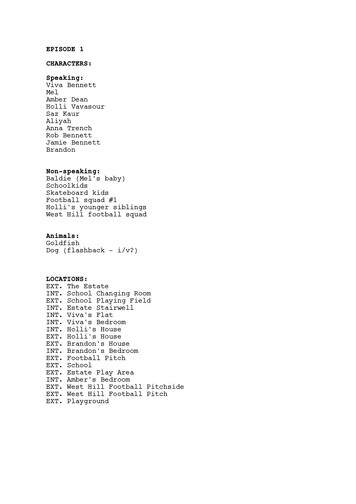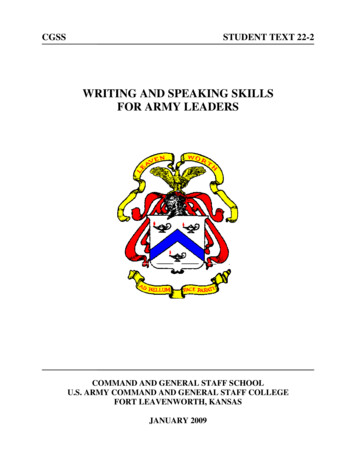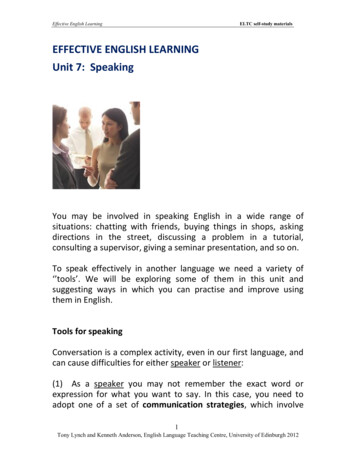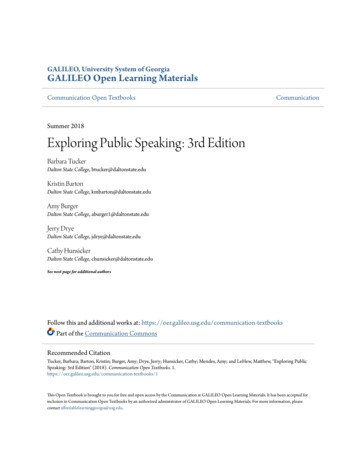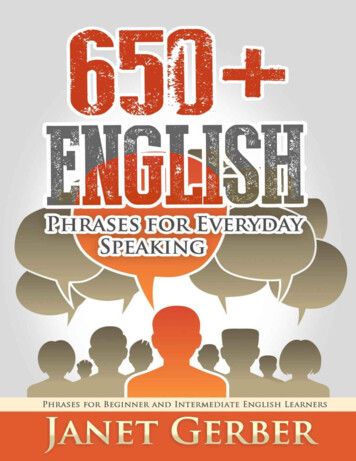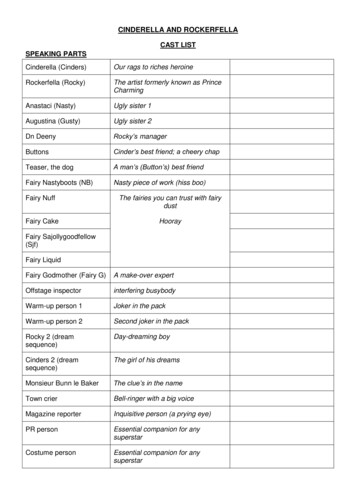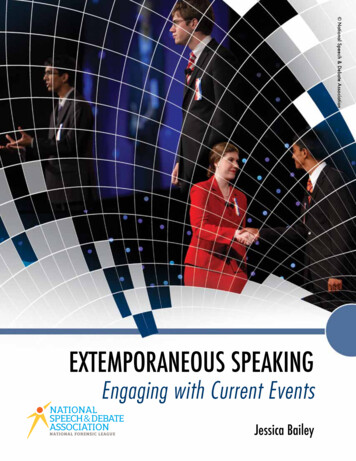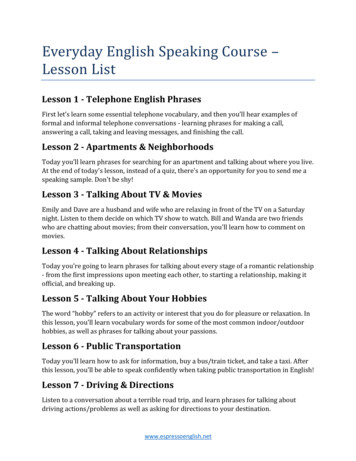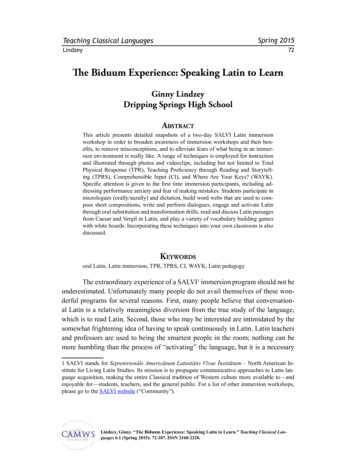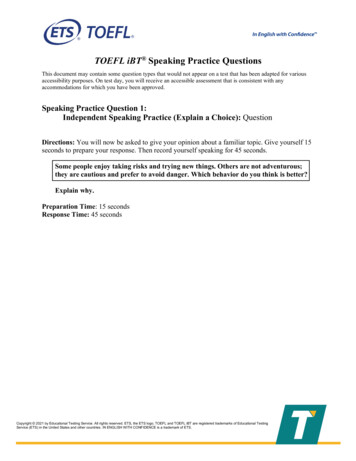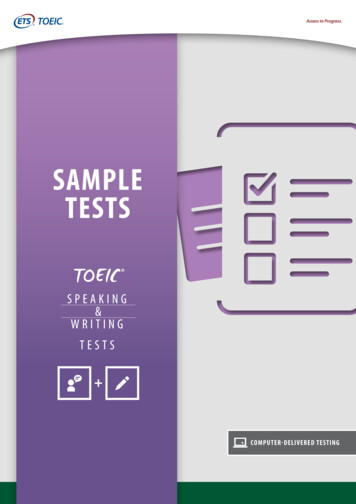
Transcription
INTO EUROPEThe Speaking Handbook
INTO EUROPESeries editor: J. Charles AldersonOther volumes in this series:Reading and Use of EnglishThe Writing HandbookListening
Into EuropeThe Speaking HandbookIldikó CsépesGyörgyi Együd
CONTENTSSeries Editor’s PrefaceAcknowledgementsPART ONE General IntroductionIntroductionChapter 1: To the teacherChapter 2: What may influence test takers’ oral performance?911171927PART TWO Designing oral examination tasksIntroductionChapter 3: The InterviewChapter 4: The Individual Long TurnChapter 5: DiscussionChapter 6: Role play35375185103PART THREE Examiner trainingIntroductionChapter 7: Training InterlocutorsChapter 8: Training Assessors135137161Recommendations for Good Practice173APPENDICESAppendix 1:Appendix 2:Appendix 3:Appendix 4:Appendix 5:Appendix 6:Appendix ixAppendixAppendixAppendixSelf-Assessment Statements for SpeakingA2/B1 Level Speaking Assessment ScaleB2 Level Speaking Assessment ScaleBenchmarks and Justifications for DVD Sample 8.1Justifications for DVD Sample 8.2Benchmarks for DVD Sample 8.2Examples of Candidate Languagefor Interpreting the Speaking Assessment Scale8: Justifications for DVD Sample 8.39: Benchmarks for DVD Sample 8.310: Benchmarks and Justifications for DVD Sample 8.411: Benchmarks for DVD Sample 8.512: Justifications for DVD Sample 8.513: List of reference books and recommended readings14: Contents of DVD191192193194195196197198
To János, Ágika and Zsófika
SERIES EDITOR’S PREFACEThe book is the second in the Into Europe series. The series in general is aimed atboth teachers and students who plan to take an examination in English, be it aschool-leaving examination, some other type of national or regional examination,or an international examination. Hopefully that examination will be a recognisedexamination which is based on international standards of quality, and whichrelates to common European levels – those of the Council of Europe.However, unlike the first book in the series (Reading and Use of English) this bookis especially aimed at teachers who are preparing their students for Englishexaminations, or who may themselves have to design and conduct oralexaminations in English. Assessing a learner’s ability to speak a foreign language isa complicated and difficult task. Not only must the teacher know what tasks to setstudents when testing their speaking ability – what the features of good tasks are,what mistakes to avoid when designing oral tasks – but the teacher must also knowhow to assess the students’ performance as fairly as possible. It is often said thattesting speaking is a subjective matter and in a sense this is true and inevitable. Butit does not have to be unreliable or unprofessional, and teachers can learn how toimprove their ability to design tasks as well as their ability to judge performancesmore reliably. This book will help all teachers who feel the need to do this.The authors of this book have long experience of teaching and assessingEnglish. Moreover, as part of a British Council Project they have for the past sixyears and more been actively involved in designing speaking tasks, in pilotingthose tasks, and in devising appropriate procedures for the assessment of students’performances. They are the authors of a series of courses aimed at making teachersmore aware of what is involved in assessing speaking, and they have developed,piloted and delivered highly successful in-service training courses to help teachersbecome more professional interlocutors and assessors. In Part Three of this book,those courses are described in more detail.The British Council-funded Project was conducted under an agreement withthe Hungarian Ministry of Education, through its agency OKI (the NationalInstitute of Education). The task of the Project was to produce test specifications,guidelines for item writers and test tasks for the reform of the HungarianSchool-leaving English Examination. The test tasks produced (Reading, Writing,Listening, Use of English and Speaking) were tested on large samples of studentssimilar to those who would take school-leaving examinations in the future. TheProject also trained raters of students’ spoken performance, and developedin-service training courses for teachers of English, to help them become aware of
10INTO EUROPE The Speaking Handbookthe demands of modern European examinations, and how best to prepare theirstudents for such examinations.It is in order to support teachers that the British Council has decided to publishthe speaking tasks that were developed, as well as videos of students performingon those tasks. Building on the authors’ experience, and incorporating theirexpertise and advice, this Handbook for Speaking is thus an invaluable resourcefor preparing for modern English oral examinations.
ACKNOWLEDGEMENTSWe would like to express our heartfelt thanks to Charles Alderson, who has beenthe consultant for the Hungarian Examinations Teacher Support Project since itsinception and without whose inspiration, unfailing encouragement and editorialsupport this book would never have been completed. We are convinced that hisuncompromising professionalism shown in test development and examinationreform in Hungary has set a great example for us and all the other Projectmembers to follow. We also wish to express our gratitude to Edit Nagy, theProject Manager, who was the originator of the British Council’s support toExamination Reform in Hungary. Without Edit the Project would never havestarted and would never have achieved what it has. We thank her for herdedication to examination reform and her endeavours in ensuring highprofessional standards in the project work. This book would never have beenconceived without Charles and Edit - Thank you!Below we list all those individuals whom we wish to thank for writing items,attending training courses, taking part in Editing Committee meetings, designingteacher-support materials and courses, benchmarking and standard setting, andparticipating in all the other diverse tasks in examination construction. We oweyou all a great debt of thanks.We wish to thank all the Hungarian secondary school students who appearedon the DVD for agreeing to be videoed during their oral examinations as well astheir English teachers and the school headmasters for their assistance andpermission to set up the pilot speaking examinations. The recordings were madein the following schools in Hungary: Babits Mihály Gimnázium (Budapest);Berzsenyi Dániel Gimnázium (Budapest); Deák Ferenc KéttannyelvûGimnázium (Szeged); Gábor Dénes Mûszaki Szakközépiskola (Szeged);Gárdonyi Géza Ciszterci Gimnázium (Eger); JATE Ságvári Endre GyakorlóGimnázium (Szeged); KLTE Gyakorló Gimnázium (Debrecen); Krúdy GyulaKereskedelmi és Vendéglátóipari Szakközépiskola és Szakiskola (Szeged);Szilágyi Erzsébet Gimnázium (Eger); Táncsics Mihály Gimnázium (Budapest);Teleki Blanka Gimnázium (Székesfehérvár).We are very happy to acknowledge the support of KÁOKSZI, currentlyresponsible for examination reform and its implementation, its former Director,Sarolta Igaz and most especially of Krisztina Szollás, who promoted the cause ofquality examination reform when we seemed to have more opponents than allies.We are also extremely grateful to the British Council for its unfaltering supportover the years, especially the support of Directors Paul Dick, John Richards and
12INTO EUROPE The Speaking HandbookJim McGrath, and their able Assistant Directors Ian Marvin, Peter Brown, NigelBellingham and Paul Clementson. We have counted on and benefited enormouslyfrom your support in good times and in bad.We also acknowledge gratefully the support of our consultants, listed below,without whose expertise, experience and encouragement, we would not have gotas far as we have.Without the enthusiastic participation of countless secondary school teachersand their principals and students, we would not have been able to pilot andimprove the test tasks: to you, we owe a great deal.We wish to thank Dezsõ Gregus of the DZ Studio, the video and DVDproduction manager, whose dedication and flexibility have always been highlyappreciated. Thanks to his professionalism, over the years since 1998 the Projecthas accumulated a large pool of high-quality video-recorded speakingexaminations, which provided the basis for the DVD compilation.And finally to our editors Béla Antal and Gábor Hingyi, and our publishers,thank you for your input, support and encouragement. We are privileged to havehad the support of the Teleki Foundation, its manager Béla Barabás, and hisassistant Viktória Csóra. We hope you are happy with the results.And to you, the reader, thank you for using this book and we hope you enjoyand benefit from the results.PEOPLE AND INSTITUTIONSBritish Council Project ManagerNagy EditKÁOKSZI Project ManagerSzollás KrisztinaEditing and layoutAntal Béla and Hingyi Gábor (?)Video and DVD productionGregus Dezsõ (DZ Studio, Szeged)Item writersÁbrahám Károlyné, Böhm József, Bukta Katalin, Csolákné Bognár Judit, Fehérváryné Horváth Katalin, Gál Ildikó, Grezsu Katalin, Gróf Szilvia, Hardiené Molnár Erika, Hegyközi Zsuzsanna, Lomniczi Ágnes, Magyar Miklósné, MargittayLívia, Nyirõ Zsuzsanna, Sándor Ernõné, Schultheisz Olga, Sulyok Andrea, SzabóKinga, Weltler CsillaTeam members developing the assessor and interlocutor training materialsGál Ildikó, Schultheisz Olga, Sulyok Andrea, Szabó Kinga, Bukta Katalin, BöhmJózsef, Hardiené Molnár Erika
13Other item writers and teachers who took part in item production, pilot examinations and benchmarking, or made invaluable commentsBarta Éva, Berke Ildikó, Czeglédi Csaba, Vidáné Czövek Cecilia, Cser Roxane,Cseresznyés Mária, Dirner Ágota, Dóczi Brigitta, Horváth József, Kiss Istvánné,Kissné Gulyás Judit, Lusztig Ágnes, Martsa Sándorné, Nábrádi Katalin, NémethnéHock Ildikó, Nikolov Marianne, Sándor Éva, Pércsich Richárd, Philip Glover, Szabó Gábor, Szalai Judit, Szollás Krisztina, Tóth Ildikó, Weisz GyörgyColleagues providing technical assistance for the ProjectHimmer Éva, Révész RitaEditing CommitteeCseresznyés Mária, Dávid Gergely, Fekete Hajnal, Gróf Szilvia, Kissné GulyásJudit, Nikolov Marianne, Nyirõ Zsuzsanna, Philip Glover, Szollás KrisztinaOKI English Team leadersVándor Judit, 1996–1999Öveges Enikõ, 1999–2000Project consultantsRichard West (University of Manchester)Jane Andrews (University of Manchester)John McGovern (Lancaster University)Dianne Wall (Lancaster University)Jayanti Banerjee (Lancaster University)Caroline Clapham (Lancaster University)Nick Saville (Cambridge ESOL)Nick Kenny (Cambridge ESOL)Lucrecia Luque (Cambridge ESOL)Annette Capel (Cambridge ESOL)Hugh Gordon (The Scottish Qualifications Authority)John Francis (The Associated Examining Board)Vita Kalnberzina (Latvia)Ülle Türk (Estonia)Zita Mazuoliene (Lithuania)Stase Skapiene (Lithuania)SCHOOLS TAKING PART IN THE PILOTING OF TASKS FOR THEHUNGARIAN EXAMINATIONS REFORM PROJECTAdy Endre Gimnázium, Debrecen; Apáczai Csere János Gimnázium és Szakközépiskola, Pécs; Babits Mihály Gimnázium, Budapest; Batthyányi Lajos Gimnázium, Nagykanizsa; Bencés Gimnázium, Pannonhalma; Berze Nagy János Gimnázium, Gyöngyös; Berzsenyi Dániel Gimnázium, Budapest; Bethlen Gábor Reformá-
14INTO EUROPE The Speaking Handbooktus Gimnázium, Hódmezõvásárhely; Bocskai István Gimnázium és KözgazdaságiSzakközépiskola, Szerencs; Boronkay György Mûszaki Szakiskola és Gimnázium,Vác; Bolyai János Gimnázium, Salgótarján; Ciszterci Rend Nagy Lajos Gimnáziuma, Pécs; Deák Ferenc Kéttannyelvû Gimnázium, Szeged; Debreceni EgyetemKossuth Lajos Gyakorló Gimnáziuma, Debrecen; Dobó István Gimnázium, Eger;Dobó Katalin Gimnázium, Esztergom; ELTE Radnóti Miklós Gyakorló Gimnáziuma, Budapest; ELTE Trefort Ágoston Gyakorló Gimnáziuma, Budapest; EötvösJózsef Gimnázium, Tata; Fazekas Mihály Fõvárosi Gyakorló Gimnázium, Budapest; Gábor Áron Gimnázium, Karcag; Gábor Dénes Gimnázium, Mûszaki Szakközépiskola és Kollégium, Szeged; Gárdonyi Géza Gimnázium, Eger; Herman Ottó Gimnázium, Miskolc; Hunfalvy János Gyakorló Kéttannyelvû Közgazdasági ésKülkereskedelmi Szakközépiskola, Budapest; I. István Kereskedelmi és Közgazdasági Szakközépiskola, Székesfehérvár; Janus Pannonius Gimnázium, Pécs; JATESágvári Endre Gyakorló Gimnázium, Szeged; Karinthy Frigyes Kéttannyelvû Gimnázium, Budapest; Kazinczy Ferenc Gimnázium, Gyõr; Kereskedelmi és Vendéglátóipari Szakközépiskola, Eger; Kölcsey Ferenc Gimnázium, Zalaegerszeg; Kossuth Lajos Gimnázium, Budapest; Krúdy Gyula Gimnázium, Gyõr; Krúdy GyulaGimnázium, Nyíregyháza; Krúdy Gyula Kereskedelmi, Vendéglátóipari Szakközépiskola és Szakiskola, Szeged; Lauder Javne Zsidó Közösségi Iskola, Budapest;Lengyel Gyula Kereskedelmi Szakközépiskola, Budapest; Leõwey Klára Gimnázium, Pécs; Madách Imre Gimnázium, Vác; Mecsekaljai Oktatási és Sportközpont,Pécs; Mikszáth Kálmán Gimnázium, Pásztó; Móricz Zsigmond Gimnázium, Budapest; Németh László Gimnázium, Budapest; Neumann János Közgazdasági Szakközépiskola és Gimnázium, Eger; Neumann János Informatikai Szakközépiskola,Budapest; Óbudai Gimnázium, Budapest; Pásztorvölgyi Gimnázium, Eger; PestiBarnabás Élelmiszeripari Szakközépiskola, Szakmunkásképzõ és Gimnázium, Budapest; Petrik Lajos Vegyipari Szakközépiskola, Budapest; Pécsi Mûvészeti Szakközépiskola, Pécs; Premontrei Szent Norbert Gimnázium, Gödöllõ; PTE BabitsMihály Gyakorló Gimnázium, Pécs; Radnóti Miklós Kísérleti Gimázium, Szeged;Révai Miklós Gimnázium, Gyõr; Sancta Maria Leánygimnázium, Eger; Sipkay Barna Kereskedelmi és Vendéglátóipari Szakközépiskola, Nyíregyháza; Sport és Angoltagozatos Gimnázium, Budapest; Szent István Gimnázium, Budapest; SziládyÁron Gimnázium, Kiskunhalas; Szilágyi Erzsébet Gimnázium, Eger; TalentumGimnázium, Tata; Táncsics Mihály Gimnázium, Kaposvár; Táncsics Mihály Közgazdasági Szakközépiskola, Salgótarján; Teleki Blanka Gimnázium, Székesfehérvár; Terézvárosi Kereskedelmi Szakközépiskola, Budapest; Toldy Ferenc Gimnázium, Nyíregyháza; Városmajori Gimnázium, Budapest; Vásárhelyi Pál Kereskedelmi Szakközépiskola, Budapest; Veres Péter Gimnázium, Budapest; VörösmartyMihály Gimnázium, Érd; 408.sz. Szakmunkásképzõ, Zalaszentgrót; Wigner JenõMûszaki Szakközépiskola, EgerGyörgyi would like to express her heartfelt thanks and gratefulness to herhusband, János for his endless love, support, encouragement and patiencethroughout the years which have led to the publication of this book. Without him
15she would never have been able to contribute to the examination reform inHungary and co-author this publication.She is also extremely grateful to Richard West of the University of Manchester,who gave her professional guidance and support during her studies at theUniversity of Manchester.Györgyi also would like to thank her former colleague and friend, Len Rix ofthe Manchester Grammar School, and her former English Assistants, Peter Neal(1993), Jonathan Prag (1994), Stewart Templar (1994-1995), Robert Neal(1995), Tom Walker (1996), Elliot Shaw (1996-1997) and Andrew DuncanLogan (1997) for their enthusiastic interest in ELT issues in Hungary, which firstinspired her to initiate school-based research projects in assessing speakingperformances, and to get involved in the examination reform project.
PART ONEGENERAL INTRODUCTIONIntroductionThe book is in three main parts. In Part One, we discuss general issues related tothe assessment of speaking ability in line with modern European standards. InChapter 1, we focus on the main features of modern English speakingexaminations: skills to be assessed, task types, levels of achievements according tocommon European standards and quality control issues such as standardisation,benchmarking and training of examiners. In Chapter 2, we review the mainvariables that may influence test takers’ oral performance in order to raise testdevelopers’ awareness of their positive or negative impact. Chapter 2 alsodiscusses the individual and the paired mode of oral performance assessment.Since test developers have full control over the design of examination tasks, inPart Two we discuss features of good and bad speaking tasks by providingexamples of different task types developed within the Hungarian ExaminationsReform Teacher Support Project. We present guidelines for item writers who wishto design interview questions (Chapter 3), picture-based individual long turn tasks(Chapter 4), discussion activities for the individual and paired mode (Chapter 5)and role plays for the individual and the paired mode (Chapter 6).Part Three deals with how interlocutors and assessors can be trained in order tostandardise speaking examinations. Chapters 7 and 8 describe the interlocutor andassessor training model developed by the Hungarian Examinations ReformTeacher Support Project. In Chapter 7, sample training activities such assimulation/role play tasks are presented in order to highlight how futureinterlocutors can gain the necessary confidence in their role. The demands of theinterlocutor’ s job are further highlighted through DVD performances that displayboth standard and non-standard interlocutor behaviour. Similarly to the training ofinterlocutors, in Chapter 8 sample activities and guidelines are presented throughwhich future assessors can be provided with hands-on experience in assessingspeaking performances both in language classes and in examination situations.Uniquely, this book illustrates different options in the assessment of speaking asit is accompanied by an invaluable resource of oral performance samples on DVD,which features Hungarian learners of English at a wide range of proficiency levels.The DVD includes carefully selected performances in order to demonstrate a number of speaking tasks in action (both good and bad tasks) how picture-based elicitation tasks work with and without question promptsfor the interlocutor;
18INTO EUROPE The Speaking Handbook whether it makes a difference if the interlocutor’ s contributions (e.g. questions and comments) are scripted/prescribed or not; how candidates’ performance differs on individual and paired discussiontasks; standard and non-standard interlocutor behaviour; sample benchmarked performances.Finally, we provide recommendations for good practice by discussing how theprinciples described for assessing speaking can be applied in classroom assessmentcontexts and how ongoing quality assurance can be provided in order to adhere tomodern European standards. The washback effect of modern European speakingexams is also considered, as teachers need to understand that high quality examsshould have a positive impact on the quality of English language teaching. Thehope is that learners will practise tasks that require them to use English in life-likesituations as part of their exam preparation. And if they learn to cope with suchtasks, they will be guaranteed to succeed in using English with real people outsidethe language classroom, as well as in the speaking examination itself.
Chapter 1To the TeacherThis handbook is intended to help teachers who have to administer or design oraltests to develop and conduct modern English oral examinations. We discuss whatis involved in the assessment of speaking ability: what it is we want to measure,what is likely to influence candidates’ performances, what task types andexamination modes can be used to elicit language for assessment purposes, andhow to prepare examiners to conduct exams and assess candidates’ performancesreliably.The most important feature of modern English examinations is that they shouldpresent candidates with tasks that resemble as closely as possible what people dowith the language in real life. Modern speaking examinations, therefore, focusupon assessing a learner’s ability to use the language in lifelike situations, in whichthey have to perform a variety of language functions. The candidate’s performancehas to be spontaneous since in real life we rarely have the chance to prepare forwhat we want to say. In real life, when two people are engaged in a conversation,they take turns to initiate and to respond, they may decide to change the topic ofthe conversation suddenly or they may interrupt each other in order to take a turn.As a result, conversations may take very different directions depending on thespeakers’ intentions. In short, the speaker’s contributions may be fairlyunpredictable in real-life conversations. In contrast, in many traditional examsettings, it is customary to allow candidates to make notes for up to 15 minutes onthe topic on which they will be examined, before they are actually required tospeak. Modern English speaking examinations, on the other hand, try to createcircumstances for candidates in which they can convey messages spontaneously.To achieve this, examination tasks engage test takers in language performance insuch a way that their contributions are not rehearsed or prepared in advance. Thiscan be ensured, for example, by using tasks that are related to carefully designedcontexts, which may be provided by a role-play situation or a set of pictures, forexample, and by training examiners to follow specific guidelines for behavioursuch as intervening when it is obvious that the candidate is reciting a rehearsedtext. The task should discourage candidates from reciting memorised texts as muchas possible because a rehearsed performance cannot provide sufficient evidencethat the learner is able to participate fluently in real communicative events.While it is obvious that candidates should be able to use the languagespontaneously in lifelike situations, it is equally important that their languageability needs to be assessed in different speech contexts. A proficient speaker iscapable of taking part in various different activities, which can be grouped intotwo main categories: productive activities (one-way information flow activities)and interactive activities (two-way information flow activities). In the formergroup of activities the language user produces an oral text that is received by anaudience of one or more listeners. For instance, the language user may be asked tospeak spontaneously while addressing a specific audience in order to give
20INTO EUROPE The Speaking Handbookinstructions or information. However, in other cases s/he may be asked to speakfrom notes, or from visual aids. In interactive activities, the language user actsalternately as speaker and then as listener with one or more partners in order torealise a specific communicative goal.In order to ensure the validity of any speaking examination, the speakingactivities should be carefully selected, taking into account the language needs ofthe target population and the purpose of the examination. Speaking activities mustalways be relevant for the candidates who take the given exam. For example, if thespeaking examination is intended for young adults who have no specific purposefor the use of English, it is highly unlikely that any of the following activitieswould be valid language use activities: giving speeches at public meetings, givingsales presentations or negotiating a business transaction. All these language useactivities are unusual as it is only a specific group of language users (businesspeople) who may be required to perform them in real life. In modern speakingexams that aim to assess candidates’ overall speaking ability in English for nospecific purpose, the following one-way information flow tasks are frequentlyemployed: describing experiences, events, activities, habits, plans, people;comparing and contrasting pictures; sequencing activities, events, pictures; givinginstructions or directions. Interactive or two-way information flow activities, onthe other hand, include transactions to obtain goods and services, casualconversation, informal or formal discussion, interview, etc.Modern European speaking examinations should provide candidates withappropriate opportunities to demonstrate that they can communicate in the targetlanguage in order to convey messages and realise their communicative goals, andin order to make themselves understood and to understand others. Naturally,learners at different levels of proficiency will perform different speaking activitieswith more or less accuracy and fluency. Learners at low levels of proficiencycannot be expected to perform the same range of language activities as learners athigher levels. In order to ensure that language proficiency is understood in similarterms and achievements can be compared in the European context, the Council ofEurope has devised a common framework for teaching and assessment, which iscalled ‘The Common European Framework of Reference for Languages’, or CEFfor short (Council of Europe, 2001). When assessing learners’ oral abilities,examination tasks should be designed in such a way that they are closely related tothe oral production and interactive activities that represent specific levels oflanguage proficiency within the Council of Europe Framework.The CEF scale has six major levels, which start with “beginner” or “falsebeginner” and go up to “highly advanced”. The levels are labelled with letters andnumbers since what is considered “false beginner” or “highly advanced” variesgreatly in different contexts. In the Framework, the lowest level is marked as A1and the highest level is labelled as C2. Each level should be taken to include thelevels below it on the scale. The descriptors report typical or likely behaviours oflearners at any given level by stating what the learner can do rather than what s/hecannot do.
Chapter 1 To the Teacher21For overall spoken production, the CEF levels are specified in the followingway:Table 1 CEF Overall Oral ProductionOVERALL ORAL PRODUCTIONC2Can produce clear‚ smoothly flowing well-structured speech with an effectivelogical structure which helps the recipient to notice and remember significantpoints.C1Can give clear‚ detailed descriptions and presentations on complex subjects‚integrating sub-themes‚ developing particular points and rounding off with anappropriate conclusion.Can give clear‚ systematically developed descriptions and presentations‚ withappropriate highlighting of significant points‚ and relevant supporting detail.B2Can give clear‚ detailed descriptions and presentations on a wide range ofsubjects related to his/her field of interest‚ expanding and supporting ideaswith subsidiary points and relevant examples.B1Can reasonably fluently sustain a straightforward description of one of avariety of subjects within his/her field of interest‚ presenting it as a linearsequence of points.A2Can give a simple description or presentation of people‚ living or workingconditions‚ daily routines‚ likes/dislikes‚ etc. as a short series of simple phrasesand sentences linked into a list.A1Can produce simple mainly isolated phrases about people and places.(Council of Europe, 2001: page 58)Note that the B2 level in the middle of the scale has a subdivision. Thedescriptor that follows immediately after B1 is the criterion level. The descriptorplaced above it defines a proficiency level that is significantly higher than thecriterion level but does not achieve the next main level, which is C1.Spoken interaction is also described at the six main levels of the Framework. Inaddition to the scale for overall spoken interaction, which has a subdivision forA2, B1 and B2 (see below), there are sub-scales available for describing learners’performance in the following areas (the page numbers in parentheses refer to theEnglish version published by Cambridge University press in 2001): understanding a native speaker interlocutor (p. 75); conversation (p. 76); informal discussion with friends (p. 77); formal discussion and meetings (p. 78); goal-oriented co-operation such as repairing a car, discussing a document, organising an event, etc. (p. 79); transactions to obtain goods and services (p. 80); information exchange (p. 81); interviewing and being interviewed (p. 82).
22INTO EUROPE The Speaking HandbookThese scales can provide detailed guidelines for test developers because thelevel descriptors for the different language use contexts clearly state what a learneris expected to be able to do.Table 2 CEF Overall Spoken InteractionOVERALL SPOKEN INTERACTIONC2Has a good command of idiomatic expressions and colloquialisms with awareness of connotativelevels of meaning. Can convey finer shades of meaning precisely by using‚ with reasonableaccuracy‚ a wide range of modification devices. Can backtrack and restructure around adifficulty so smoothly the interlocutor is hardly aware of it.C1Can express him/herself fluently and spontaneously‚ almost effortlessly. Has a good command ofa broad lexical repertoire allowing gaps to be readily overcome with circumlocutions. There islittle obvious searching for expressions or avoidance strategies; only a conceptually difficultsubject can hinder a natural‚ smooth flow of language.B2B1A2A1Can use the language fluently‚ accurately and effectively on a wide range of general‚ academic‚vocational or leisure topics‚ marking clearly the relationships between ideas. Can communicatespontaneously with good grammatical control without much sign of having to restrict whathe/she wants to say‚ adopting a level of formality appropriate to the circumstances.Can interact with a degree of fluency and spontaneity that makes regular interaction‚ andsustained relationships with native speakers quite possible without imposing strain on eitherparty. Can highlight the personal significance of events and experiences‚ account for and sustainviews clearly by providing relevant explanations and arguments.Can communicate with some confidence on familiar routine and non-routine matters related tohis/her interests and professional field. Can exchange‚ check and confirm information‚ deal withless routine situations and explain why something is a problem. Can express t
the speaking tasks that were developed, as well as videos of students performing on those tasks. Building on the authors’ experience, and incorporating their expertise and advice, this Handbook for Speaking is thus an invaluable resource for prepari
